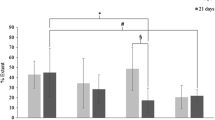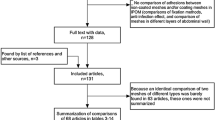Abstract
Adhesions between viscera and mesh may result in intestinal obstruction and fistulae formation. Fewer adhesions with sodium carboxymethylcellulose (SCMC)-coated polypropylene mesh (PM) has been reported, but impaired wound healing was the major concern. We investigated the adhesion-prevention effect of SCMC in different concentrations, as coating only on visceral face of PM and its effects on wound healing. A full-thickness abdominal wall defect was created in 28 rats, which were then divided into three groups. In Group I (control), the defect was repaired with PM only; in Group II and Group III, the defects were repaired with 1% and 1.6% SCMC-coated-PM, respectively. All animals were sacrificed at day 30, and histological evaluation and adhesion scoring were done. Animals in the group in which 1.6% SCMC-coated PM was used developed significantly fewer adhesions compared with other animals (P=0.04). Histological evaluation using a semiquantitative scoring system showed no difference between the groups in fibrosis and inflammation scores (P=0.9 and P=0.3, respectively), and thickness of fibrosis on mesh was also similar (P=0.5). SCMC in 1.6% concentration as coating only on the visceral face of PM reduced the incidence and severity of adhesions without impairing wound healing.
Similar content being viewed by others
References
George CD, Ellis H (1986) The results of incisional hernia repair: A twelve-year review. Ann R Coll Surg Engl 68: 185–187
Kaufman Z, Engelberg M, Zager M (1981) Fecal fistulae: A late complication of Marlex mesh repair. Dis Colon Rectum 24: 543–544
Fernandez LR, Martinez SC, Ortega DP, Lopez JM, Lucas FJ, Morero AM (2001) Colocutaneous fistula due to polypropylene mesh. Hernia 5 (2): 137–139
Losanoff JE, Richman W, Jones W (2000) Entrocolocutaneus fistula: a late consequence of polypropylene mesh abdominal wall repair: case report and review of the literature. Hernia 6: 144–147
Simmermacher RJK, Schakenraad JM (1994) Reherniation after repair of the abdominal wall with expanded PTFE. J Am Coll Surg 178: 613–615
Alponat A, Lakshmınarasappa SR, Ming T, Rajnakova A, Moochhala S, Goh PM, Chan ST (1997) Effects of physical barriers in prevention of adhesions: An incisional hernia model in rats . J Surg Res 68: 126–132
Alponat A, Lakshmınarasappa SR., Yavuz N, Goh PM (1997) Prevention of adhesion by Seprafilm; An Absorbable adhesion barrier: An incisional hernia model in rats. Am Surg 63: 818–819
Malazgirt Z, Ulusoy AN, Gök Y, Karagöz F, Taç K (2000) Bioabsorbable membrane prevents adhesion to polypropylene mesh in rats. Hernia 4: 129–133
Hooker GD, Taylor BM, Driman DK (1999) Prevention of adhesion formation with use of sodium hyaluronate-based bioresorbable membrane in a rat model of ventral hernia repair with polypropylene mesh. A randomized, controlled study. Surgery 125: 211–216
Hemadeh O, Chilukuri S, Bonet V, Hussein S, Chawdry JM (1993) Prevention of peritoneal adhesions by administration of Carboxymethylcellulose and oral vitamin E. Surgery 114(5): 90–94
Greenawalt KE, Butler TJ, Rowe EA, Finneral AC, Garlick DS, Burns JW (2000) Evaluation of sepramesh biosurgical composite in a rabbit hernia repair model. J Surg Res 94(2):92–95
Mueller PO, Hay WP, Harmon B, Amoroso L (2000) Evaluation of a bioresorbable hyaluronate-carboxymethylcellulose membrane for prevention of experimentally induced abdominal adhesions in horses. Vet Surg 29(1): 48–53
Osada H, Minai M (1999) The effect of hyaluronic acid Carboxymethylcellulose in reducing adhesion reformation in rabbits. J Int Med Res 27(6):292–296
Çubukçu A, Alponat A, Gönüllü NN, Özkan S, Erçin C (2001) An experimental study evaluating the effect of Mitomycin C on the prevention of postoperative intraabdominal adhesions. J Surg Res . 96(2): 163–166
Çubukçu A, Alponat A, Gönüllü N (2002) Mitomycin C prevents reformation of intraabdominal adhesions after adhesiolysis. Surgery 131(1): 81–84
Bauer SS, Salky BA, Gelernt IM, Kreel I (1987) Repair of large abdominal wall defects with expanded Polytetrafluroethylene (PTFE). Ann Surg 206(6):765–769
Balen EM, Diez-Caballero A, Hernandez-Lizoain JL, Pardo F, Torramade JR, Regueira FM, Cienfuegos JA (1999) Repair of ventral hernias with expanded polytetrafluoroethylene patch. Br J Surg 86(5): 712–713
Amid PK, Shulman AG, Lichtenstein IL, Sostrin S, Young J, Hakakha M (1994) Experimental evaluation of a new composite mesh with the selective property of incorporation to the abdominal wall without adhering to the intestines. J Biomed Mater Res 28: 373–375
Petroianu A, de Carvalho LB, Rocha KE, Barbosa AJ (1999) Prevention of abdominal adhesions does not interfere with jejunal anastomosis healing. Int J Surg Investig 1(2):149–156
Uzunköy A, Akıncı OF, Coşkun A, Aslan O, Koçyiğit A (2000) Effects of antiadhesive agents on the healing of intestinal anastomosis. Dis Colon Rectum 43(3): 370–375
Piaggesi A, Baccetti F, Rizo L, Romanelli M, Navalesi R, Benzi L (2001) Sodium carboxymethycellulose in the management of deep ulceration of diabetic foot. Diabet Med 18(4): 320–324
Hay WP, Mueller PO, Harmon B, Amoroso L (2001) One percent sodium carboxymethylcellulose prevents experimentally induced abdominal adhesions in horses. Vet Surg 30(3): 223–227
Author information
Authors and Affiliations
Corresponding author
Rights and permissions
About this article
Cite this article
Yelimlieş, B., Alponat, A., Çubukçu, A. et al. Carboxymethylcellulose coated on visceral face of polypropylene mesh prevents adhesion without impairing wound healing in incisional hernia model in rats. Hernia 7, 130–133 (2003). https://doi.org/10.1007/s10029-003-0125-1
Received:
Accepted:
Published:
Issue Date:
DOI: https://doi.org/10.1007/s10029-003-0125-1




